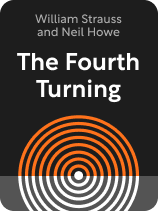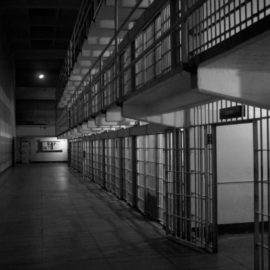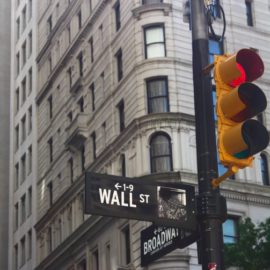

This article is an excerpt from the Shortform book guide to "The Fourth Turning" by William Strauss and Neil Howe. Shortform has the world's best summaries and analyses of books you should be reading.
Like this article? Sign up for a free trial here.
What are the four cycles of history? Based on recent American history, does the “four Turning” theory hold water?
In The Fourth Turning, William Strauss and Neil Howe explain that human history is characterized by a cyclical progression through four “Turnings.” The First Turning is a High, the Second Turning is an Awakening, the Third Turning is an Unraveling, and the Fourth Turning is a Crisis.
Read on to learn what characterizes each Turning; how the most recent First, Second, and Third Turnings played out; and the authors’ predictions for the next Fourth Turning.
The Cycle of the Four Turnings
Like a single phase of a human life, a Turning lasts around 15 to 25 years. A single cycle of history is called a saeculum. Turnings aren’t characterized by the events that occur during them but rather by society’s reactions to those events.
The saeculum theory is based on a cyclical view of time—the idea that the same themes and types of events recur and will continue to recur throughout history—as opposed to the chaotic theory, which views time as a series of random and unrelated events, or the linear theory, which views time as a non-recurring progression with a definite start and end.
(Shortform note: Other writers have proposed a fourth theory of time known as the spiral theory. This combines the cyclical theory with the linear theory. It suggests that, while themes and events do recur throughout history, we can also learn and improve as time goes on and shift the spiral up—or we can continue to make bad choices and shift the spiral down. In the spiral theory, “turnings” and “saecula” don’t exist because there’s a greater focus on change than on recurrence. Like the cyclical theory, the spiral theory shows that we can better handle upcoming changes if we’re aware of them and prepare for them, but it also grants us the agency to improve ourselves and society in the long term.)
The actions of a society can’t stop the cycle, but we can prepare for each Turning by studying previous cycles of history and the effects they had on society. We can then ease transitions by shifting our activities based on the Turning we’re currently in and anticipating the next one. On an individual scale, this means preparing in advance for the financial and cultural challenges the next Turning might pose. On a societal scale, this means governments should anticipate the shifts in public sentiment and alter their programs and agendas to suit them.
(Shortform note: The types of large-scale, society-wide changes needed to prepare for a Turning require the ability to shift cognitive sets—to switch behaviors or mindsets to fit different tasks or contexts. In the wake of the COVID-19 pandemic, with the prospect of returning to previous modes of life—a monumental transition for society—experts claim that society at large will need to utilize this ability to help make the transition easier for all of us. While we don’t know exactly when the transition will happen or what it will look like, knowing that it will happen will help us maintain some control over it so we can navigate the changes smoothly.)
The First Turning: A High
According to the authors, a High occurs after a period of great turmoil is resolved. During a High, a new social order is put in place. Government is strong and active, and public services are expanded. Values like individualism fall out of fashion and are replaced by more collective values. Income inequality and unemployment fall, and productivity increases. Class inequality also falls, but gender gaps increase. Children are given greater autonomy.
America’s Most Recent First Turning
The First Turning of our current saeculum lasted from 1946 to 1964, explain the authors. With the Crisis of the war over, the G.I. generation returned from war with renewed optimism and a sense of collective purpose. They were welcomed back home as brave champions and began forming secure, prosperous families.
During this Turning, the elder Lost (Nomad) generation was leading with the wisdom built by living through two world wars and the Great Depression. The (Hero) G.I.s in midlife built their nation to its greatest point in history so far. The young adult Silent (Artist) generation married early and avoided risk.
During the American High, trust in government and institutions was high. Income inequality dropped, and the middle class flourished. Families grew, leading to the mass building of suburbs. Racism and sexism brewed, materialism was rampant, and nonconformity was stigmatized.
The Second Turning: An Awakening
An Awakening occurs when people pull away from the social order imposed during the High, resulting in a cultural revolution. People question and defy the institutions and regulations established during the High as the need for them falls out of living memory.
People also reject collective values and the ideals of duty and conformity in favor of individual rights. Government weakens, and free markets begin to overshadow public services. Violence and crime increase, as do income inequality and class divisions. Gender divisions become less strict, and child-rearing becomes more lenient.
America’s Most Recent Second Turning
The Awakening that followed the American High lasted from 1964 to 1984, and the authors termed it the Consciousness Revolution. Its beginning was sparked by the assassination of John F. Kennedy, which shook the nation and incited new social movements rebelling against the now well-established government and social institutions from the High.
Confidence in the nation’s G.I.-built institutions began to waver. People no longer accepted the costs of these institutions.
Boomer Prophets entered young adulthood with no memory of the wartime plights that necessitated these systems. Hero G.I.s (now elders) watched on as the Boomers rebelled against what they had built. Simultaneously, Boomers and the Silent Artist generation (young adults and midlifers) were raising Nomad Xennial children with hands-off parenting styles. The era saw the nation’s highest divorce rates ever.
Violence spread, both in the public eye and on a smaller scale. The Vietnam War further eroded public faith in leadership. As with the moon landing, people felt that the resources spent on this endeavor would be better applied on the homefront to ending poverty and social and racial inequality.
The clash between social movements and American materialism led to economic conflict in the 1970s. Environmentalist movements called for a reduction in energy consumption and construction, which led to a decrease in economic supply. Inflation added to this economic crisis and resulted in a stagnation of wages that took years to recover from.
The focus on the individual created a culture of self-centeredness that rejected the idea of duty to one’s nation. As the Turning came to a close, individualist sentiment spread to the realm of politics and economics. Conservatives embraced this new ideology and capitalized on the country’s newfound fierce individualism to reignite the Republican party.
The Third Turning: An Unraveling
An Unraveling occurs when society embraces the new order put in place during the Awakening. Trust in government and establishments continues to decline, and people become more passionate about and extreme in their beliefs. Communities become divided over morals, and unified action becomes more difficult.
People become tribal or nationalistic and suspicious of anything that doesn’t fit their values. Individualism is at its highest, and free markets become even more favored. Violence, crime, and income inequality reach their peak. Gender divisions are even less strict, and society becomes more protective of children.
America’s Most Recent Third Turning
The Culture Wars following the Consciousness Revolution began in 1984 and were still ongoing at the time of this book’s publication in 1997. The authors roughly estimated that it would last through 2005 but acknowledged that it could end a few years earlier or later. During this time, the new system of individualistic values established during the Awakening had become mainstream.
The elder Silent Artist generation led ineffectually and indecisively. They failed to produce a single president during this Turning, a generational anomaly that had never happened before.
Meanwhile, Boomer Prophets entered midlife as judgmental leaders heavily fixated on black-and-white values that they were unwilling to compromise on. Xennial Nomads came into adulthood feeling alienated and ignored and with a fragmented generational identity.
Trust in the government reached its lowest point, but polls showed a high level of individual self-esteem. People began dividing into groups based on shared interests or characteristics such as gender, race, class, and religion, which led to discord between groups. Each group saw themselves as victims of their opposing group.
The three main cultural “wars” during this time were over inclusivity and diversity, religion, and free market economics. Voters became more polarized. The number of independents and nonvoters grew. Politicians and political ads became brutally hostile.
Income inequality continued to grow, and homeless people were funneled into prisons. Companies laid off workers. Society became cynical, fragmented, and mistrustful—both of other people and of the government. There was a general sense that society was helplessly declining and heading toward disaster.
The Fourth Turning: A Crisis
A Crisis occurs when a catalyst ignites a significant change in society. The anxious, pessimistic, and pre-cataclysmic mood of the Unraveling primes people to respond in a way that creates a societal upheaval.
In response to the panic, people begin to unite as communities to establish a new social order that demands collective sacrifice to resolve the nation’s problems. The government is appointed to implement and enforce this social order.
Violence, crime, and income inequality decrease. Gender divisions increase again. Protectiveness over children is at its highest.
The risk of national violence such as revolution, civil war, and foreign war increases. Leaders characterize foreign and political opponents as immoral and refuse to compromise, and the use of highly destructive weapons increases for the sake of decisive victories.
As a result of the Crisis, society is unrecognizably transformed. The resolution of the Crisis cements the new social order and results in an end to wars.
America’s Next Fourth Turning: Predictions
The authors, writing in 1997, expected that the Fourth Turning—a Crisis—would begin around 2005. The authors make a handful of predictions about what the next catalyst might look like:
A terrorist attack by a foreign group purporting to have nuclear weapons, leading the US to declare war and begin searching people’s homes. Suspicions that the president fabricated the event result in a nationwide strike and the loss of foreign capital.
A new, highly contagious virus spreads, causing significant deaths and leading the government to create and enforce quarantines. The National Guard is deployed, and the president is pressured to declare martial law.
Conflicts in and around Russia result in civil wars and the capture of American diplomats, leading the US to send ships into the Black Sea and Congress to consider reinstating the draft.
The authors note that the exact scenarios are unknown and that, whatever does happen, the country will mitigate it before it becomes truly devastating. However, the crisis will arise from some problem that the country had failed to address, which will spark outraged calls to action.
Eventually, through some combination of larger conflicts, the nation’s issues will coalesce into one large problem that forms the climax of the Crisis. People will unify around this problem, setting aside differences for the purpose of healing the nation and putting it on track for a new rebirth in the upcoming High. Ultimately—whether better or worse—the nation will be unrecognizable from what it was at the beginning of the Crisis.

———End of Preview———
Like what you just read? Read the rest of the world's best book summary and analysis of William Strauss and Neil Howe's "The Fourth Turning" at Shortform.
Here's what you'll find in our full The Fourth Turning summary:
- How Anglo-American history follows a pattern of four 15 to 25-year periods
- How the behaviors of different generations define these Turnings
- Predictions about the next Turning—a Crisis






